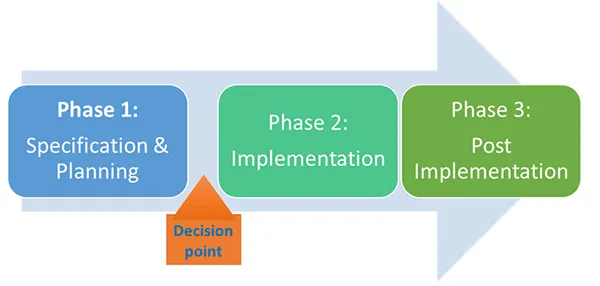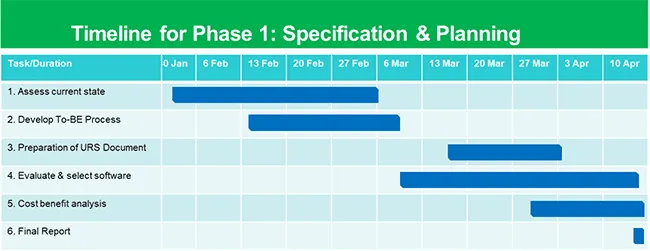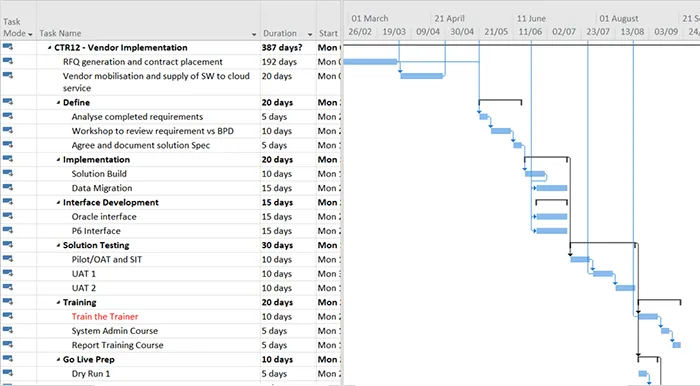How to Create a BPM Implementation Project Plan
Table of contents

BPM implementation requires a rock-solid methodology to be successful and to reach your business objectives. In this article, we lay out everything you need to create a winning implementation plan.
Introduction
Investment in any Business Process Management (BPM) system is always significant. Even if the chosen software solution is inexpensive, the cost of the implementation time and the resources will certainly not be. So, we need to ensure that we have some clear objectives and a strategy for the way forward.
In setting out on this journey, we see three distinct BPM Implementation phases:

Phase 1: Specification & Planning
BPM Implementation Steps
This phase is about preparation for implementation. The key BPM implementation steps in this phase will be:
- Setting a clear scope, vision, and strategy
- Stakeholder Buy-in
- Documenting the Current Processes
- Developing a To-Be process Model
- Preparation of User Requirements.
- Evaluation and Selection of Software Solutions.
- Building a Business Process Team and Organization Structure
- Developing a Budget and Detailed Implementation Plan
- Approval to Proceed
Sample Timeline for this Phase

Setting a Clear Scope, Vision, and Strategy
This is what you want the effort to achieve. BPM can range in scope from a single process to an initiative that covers an entire organization. It can vary from a small project that simply documents and inventories all processes to a full-blown enterprise-wide deployment of business process management technology. So, it is imperative to set clear objectives of what you want to achieve. Successful system implementation will significantly impact an organization, and this can only be achieved with senior leadership support and sponsorship. Ensure that the BPM objectives align with the strategic corporate objectives of the organization. Develop an inclusive project charter with broad appeal
Stakeholder Buy-in
These will be people with interest in the outcome of the implementation over the lifetime of the project. Typically, it will be
- Senior Executives
- IT
- Project Team
- Process Experts/Analysts/Process owners
- End Users
An essential part of any process implementation will be to secure all stakeholders' buy-in – but in particular, the senior executives who will endorse and sponsor this phase and the implementation phase.
Documenting the Current Processes
If you do not have a clear, up-to-date document of your current way of working, then you will need to do this. You cannot analyze opportunities for process improvement if the process is not fully defined.
Developing a To-Be process Model
Your process model will cover the agreed scope. The current processes will need to be analyzed and streamlined to develop an optimized way of working. This will need to be carried out by small evaluation teams with input from the process users, the process owners, and business analysts who can ask what 'business value' the existing process offers?
Preparation of User Requirements
Documentation will need to be developed that sets out the business requirements for a BPM solution. It will define the critical (must-have) requirements of potential software solutions and the nice-to-have offerings. In evaluating potential software solutions, this document focuses on the real needs of the business and distracts from focussing on the bells and whistles of the technology offering - what looks cool or jazzy but has little benefit to the organization.
Evaluation and Selection of Software Solutions
In line with preparing the user requirements, the business will need to scan the marketplace of potential offerings that would suit the business. This will need to consider the current and potential future scope of requirements.
Selection of the final software solution will not only consider how well the solution meets your user requirements but also:
- The company performance and track record
- The technology offering in terms of what is available today and the future development path
- the current user base of the software and its relevance to your business
- The general look and feel of the solution
- First-hand feedback by site visits to current users.
- The ongoing support
- Implementation support
- The total cost of ownership
Implementation Approach
As outlined in the early points, you need to scope what you are going to achieve. It is always better to phase the implementation into several stages to give a better chance of success. This may be phased by the processes you will focus on; for example, the business may consider the customer relationship management a priority, so you will start with them and then the operations and then finance, etc. Remember to have a pilot phase, where you can check out the full functionality of the solution but with a limited set of data and a limited set of users. (A small subset of your business that will validate the operation of the solution). This will mitigate the horrors of releasing software that is not thoroughly tested to the user community.
Building a BPM Team and Organization Structure
As with any project, having the right project team and organization in place to implement a business process system is crucial. A typical project team and organization structure will include:
- Steering Committee of senior decision-makers
- Project Manager
- Process expertise/Business Analysts
- IT expertise
- Key Users
- Key process owners
- Vendor support team
The size and level of support will depend upon the size and scope of your BPM implementation and the skills available within the organization.
It is crucial to identify the internal support needed from the business and ensure this is seconded to the project. So many projects fail because internal resources are committed in the planning phase, but they are not available during implementation because they are still doing the day job. A strong business leader will be needed to manage the project, who respects the leadership team, can bring on the input from the user community, and can work with the IT/digital support functions as well as manage the external vendors.
Bringing in external expertise (independent from the software vendor) to support your project is strongly recommended as it will increase the chances of success. They will have been through the experience and the process many times before and can guide you through the pitfalls and short-cuts. They can also fill in the expertise and capacity gaps for resources that your organization may not have.
Developing a Budget and Detailed Implementation Plan
To obtain approval to proceed, a business case needs to be developed in line with the company's Capex requirements. This will need to set out all the implementation costs, including time spent to date in this preparation phase. The benefits will also need to be quantified and time-phased to return on investment and payback period. Typically, projects of this nature are capitalized over five years. In addition, a detailed implementation plan will be required against which the progress in terms of cost and timescales can be monitored.
Approval to Proceed
The objective of this planning phase is to ensure that the project can justify itself and that senior leadership is ready and willing to provide the funding for the project and make their total commitment to ensuring its success. This undertaking will require changes in people's roles, responsibilities, and the work they perform. This all means change, so management needs to be fully supportive and be prepared to address the potential change management issues that the project will present.
Phase 2: Implementation
Knowing that you have the approval and the management commitment behind you is a great way to start, but it is only the beginning. The real work starts from here onwards. Doing the preparation work set out above will make the implementation less stressful and provide a better chance of a successful outcome. From herein, it is the responsibility of the implementation team to deliver the set outcomes. The key considerations in this phase will be:
- Communications. No matter how much you communicate, it will not be enough. You must have a formal process for communicating up the chain to the leadership team, the workforce, and of course, within the team. Newsletters, webinars, posters (on the wall or digital via intranets) will all help, but there is nothing like talking to people. This should be done not only by the team leader or assigned people, but all the team members should be encouraged.
- Training. Ensure that you have a training plan that details which you will train, what parts of the solution, and when. Developing good training material will be an asset as you move into the go-live stage. People may likely change roles, new people may come into the business, or your existing users may need refresher courses. The investment in suitable training materials will become an ongoing requirement. Hands-on is still the best approach but remember that videos and computer-based training (CBT) modules can be re-used many times.
- Interfaces/Integration with other systems. Depending upon the state of the organization's legacy systems, this may become a more significant challenge than perceived. Ensure that you thoroughly evaluate the benefits of trying to interface with systems that are no longer supported.
- Accuracy and availability of data. Remember the adage garbage-in equals garbage-out. If your data is out of date or inaccurate, then you will not get meaningful information that the business can use for decision-making. Data issues should have been identified at the preparation stage to be created, refined, and validated as part of the implementation.
- Management of the team. We have already outlined the need for a strong project team and organization structure, but they will need careful management and alignment to the project goals. Bringing any team together takes time and effective coaching. You only have to look at the sports industry's efforts in building strong, successful teams and team leadership. You will need to invest some time and ensure that the project manager can coach and manage his team.
- Celebrate early successes. It is important to celebrate achievements, even small achievements, early on in the implementation phase. This gives confidence to the team, senior leadership, and the user community that the project is going well.
- The formal process for addressing change management issues. One of the biggest hurdles will be making changes in the user base's daily work routines, and they will feel vulnerable. Some may not even stay on the journey, so be prepared for this. Follow the To-Be process model, and when changes arise, as they will, have a formal process for dealing with them, including process owner sign-off.
- System and User Testing. As already outlined under implementation, ensure that you develop a Pilot. Also, as part of your implementation approach, consider how many system environments you will need. Apart from a Production environment, it is good to have at least a Test environment and think about a different Training environment. No solution should be released to users unless it has been fully system and user-tested.
- Progress Reporting. No project will go according to the initial plan, so be prepared for that. Have a regular progress reporting mechanism to update the senior management and change the plan as required. It is a working document but ensure that you measure progress from the initial plan. (This should be your baseline).
Example of a Detailed Implementation Plan

Phase 3: Post Implementation
Once the system has gone live, which is likely to be in phases, there needs to be a plan of the post-implementation activities. Some of these will include:
- Ongoing support provision. Consideration will need to be given to how the system will be supported internally and with vendor support. It is crucial to have an internal coordination function that becomes the first point of user support. Only after they have assessed the problem should the vendor be involved. This usually is part of your IT function.
- Benefits realization. You will need metrics to measure the business's success and ensure that the investment provides the expected returns. Many organizations find it challenging to assess this. However, if thought is given to this in terms of the metrics before implementation and then measurements after go-live, then the achievements can be measured. These metrics will be driven by the expected benefits set out in the business case.
- The mindset of continuous improvement needs to be built into the process. No business stands still, and it may be that it took few years from the time of as-is assessment to embedding the new process. In that time, the needs of the business may have changed; new product lines added, changes made in the organization structure, key people have left taking valuable process knowledge with them, the vendor has launched a new version of the solution. The business will need to provide regular changes to the prescribed solution based on the market and business conditions. Skills and processes need to remain in the organization to realize the ongoing improvement opportunities.
Conclusion
Finally, do not think of BPM as a project with a finite beginning and end. Yes, there are definable steps involved, but BPM is more about a journey toward process optimization and an approach to making that happen. Remember that you are building a system for anticipating and managing changes as circumstances change or technology advances. As noted above, implementing BPM requires planning, communication, and hard work, but once people see their ideas come to life and processes become optimized, they will understand why BPM exists and what it does for the organization.

Mike Raia
Marketing the world's best workflow automation software and drinking way too much coffee. Connect with me on LinkedIn at https://www.linkedin.com/in/michaelraia/(opens in a new tab)




